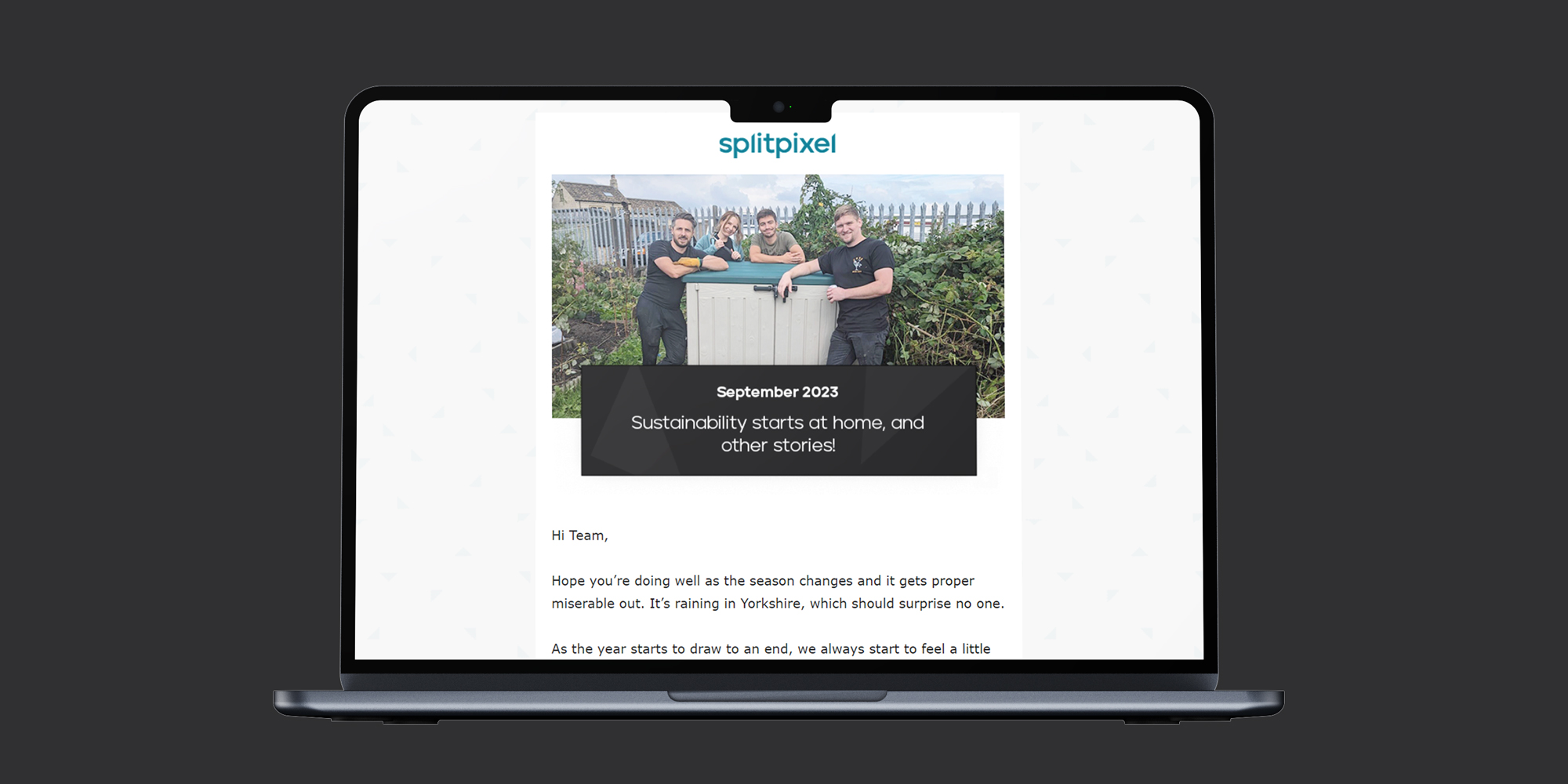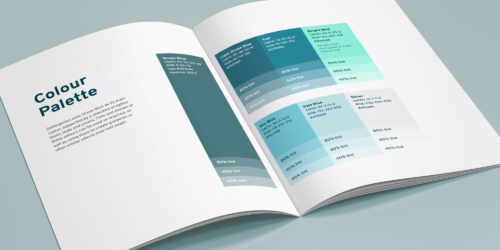With a seemingly endless stream of ever-changing advice clogging up our feeds (and brains), Splitpixel’s resident social media marketing nerd lists their top eight dos and don’ts for social media marketing.
One of my biggest frustrations when browsing LinkedIn is finding myself wading through an endless supply of contradictive social media marketing advice – often from self-proclaimed social media gurus who’ve said literally the opposite thing just a week before.
So I wanted to put a few common problems to bed once and for all (through the medium of Gina Linetti gifs) – because the topics I’m about to cover aren’t going to change by next week, or next month… or next year!
We’re not talking about playing to any social media algorithms or covering any of the latest hot trends. We’re talking about the fundamentals, the basics, the things that you need to understand before you move on to the fun stuff.
So without further ado, here are my top eight dos and don’ts for social media marketing.
Do lead with value in your content.
But DON’T sound too salesy or self-promoting (at least not straight away). Social media is a bit like radio. When you’re listening to the radio, you expect there to be adverts, right? But you listen because:
- You like the music; the host is entertaining and there’s good value.
- The adverts are few and far enough between that they don’t bother you too much.
Sometimes, you even get taken in by a well-placed advert – because the radio station understands the demographic of its listeners and they’ve advertised something that you’re actually interested in.
When you feed your social media followers high value content – let’s say 80% of the time – they’re more likely to be receptive of the 20% of posts that focus more on why your business is so great and why people should buy from you or work with you.
![]()
When you’re creating content for social media, think about how best to reel your audience in. If your first sentence jumps straight into talking about how great you are, you’ve already gone wrong.
But, if your hook addresses one of your audience’s pain points (why they need your product/service) before providing some juicy content about how to overcome that relatable challenge – well, they’re more likely to read on.
Once you’ve provided value, then you can focus more on what you do, how you can help, and drop in a strong CTA (call to action) in there so they know what to do next.
Do use trending topics to increase your brand visibility.
But DON’T hop on a trend without thinking about your target audience. We love fun social media content as much as the next person – and trends can be fun way to show your brand personality, your lovable team, or your business values.
But some trends just aren’t the right fit for your brand. Trying to force content that doesn’t benefit your business, doesn’t resonate with your existing audience, and won’t necessarily help you gain any new engaged users, seems like a waste of time to us.
Best case scenario, it’s a one-off cringe moment that’s quickly forgotten. Worst case scenario, you do real damage to your brand reputation and start haemorrhaging engaged followers.
So, even though it’s good to act quick when a trend takes off (because you want to stay ahead of the curve), it’s better to take it steady and really think about whether this trend fits well with your brand.
![]()
Do consider posting to multiple social media platforms.
But DON’T spread yourself so thinly across so many platforms that you don’t have time to create high value content. It can take some time (and a good amount of research) to find the right social media platforms for your business. Often, it’s a case of trial and error!
Look at your buyer personas and choose the social media platforms where your target audience is most likely to hang out. It’s going to take a while to get a good idea of what works and what doesn’t. Don’t sack off a platform after just two months if you’re not getting the results you wanted.
It might be that your content isn’t suited for your audience. Maybe you’re not posting at optimal times? Or maybe you’re right and it is just that the platform isn’t ideal for your business. But if you’re wrong, you might end up missing out on countless opportunities!
![]()
Some agencies will tell you that your business should be on all the mainstream social media platforms because “imagine how annoying it is when your customers can’t find you on the platform that they like to use” and that’s a fair point. But we see things from a different perspective…
Imagine how annoying it is when you’re creating content for five social media platforms when two of those platforms only count for 3% of your total target audience!
And imagine how much more annoying it is for the other 97% of your audience that’s left with lower quality content because you’re trying to manage too many platforms – *click* unfollow.
Do try to introduce some consistency to your content.
But DON’T create an inflexible social media style guide that limits your opportunities for content! Social media is very much in-the-moment marketing. And sometimes you need to be flexible with your branding so that you can share a timely meme or team photo.
But consistency is part of what makes your brand easy to recognise. Your brand guidelines – colours, fonts, logo placement etc. – help to create a consistent digital brand image that can inspire confidence, build trust and familiarity, and give your content that polished and professional feel.
![]()
Like most things, it’s all about balance – and making the most of certain social media platform features that allow you to be flexible when the need arises.
For example: Most platforms are getting, or already benefit from, a stories feature. Stories last for 24 hours before disappearing (but you can save them to highlight reels on some platforms, like Instagram).
If you want to share a post that doesn’t quite fit with the rest of your content, consider posting it to your stories. After all trends are often short-lived, so 24 hours might be just enough time to make an impact before the trend dies down!
Do look at what your competitors are posting.
But DON’T forget to look at how it performs as well! We cannot stress this one enough – and it should probably go without saying. Your competitors could be getting it wrong!
![]()
And while you can’t see your competitor’s CTR (click through rate), you can look at likes, comments, shares and so on, to get a better idea of how their posts are performing. If they’re not getting much attention, it’s not 100% proof that what they’re posting doesn’t work – but it’s something to consider.
And if you still want to have a go at posting content like theirs, consider running an A/B test! Choose one of your goals (e.g. increase traffic to ‘X’ landing page) and create two pieces of content that aim to do just that – one post modelled off content you’ve been sharing to fulfil that goal, and one post modelled of what your competitors have been doing to that same end.
It could be that your competitor’s content is a bit rubbish, but now you know what not to do. Crack open a beer. At least we learned something!
Or it might be that engagement on the competitor-inspired post is low but CTR is high – and you’ve happily stumbled across a brilliant way to boost website traffic. Crack open a beer! Proper chuffed for you.
Do make time for social listening.
But DON’T let it take over your day. Left unchecked, social media can eat up big chunks of your day and leave you feeling unproductive, dissatisfied, and a bit burned out to be honest!
That’s why it’s important to schedule time for social listening and also know when to pull the plug, put your phone down and focus on something else for a while.
![]()
But what is social listening? In short, it’s the good practice of monitoring your social media channels and any relevant third-party social media profiles to gain insight into your customers, identify opportunities and measure how well your social media content is performing. In short.
And that takes time! There are tools to help you speed things up. For example, when social listening for our clients, we use a social media management tool called AgoraPulse. It helps us track mentions of our clients’ brands, view any relevant comments, respond to conversations, track hashtags, and keep an eye on competitors.
Dedicating time to social listening will help you feel more connected with your audience and find our what they care about most – and knowing that will help you create content that they want to see!
![]()
Pop something in the diary, set a timer – do whatever it is you need to do to ensure you’re spending enough (but not too much!) time following what your customers are saying and doing online.
Do respond to negative feedback in reviews and comments.
But DON’T get sucked into an argument. So, now we’re spending time on our social listening, we might come across some comments that we don’t really want to see. Perhaps someone has had a bad experience with one of your products. Maybe they’ve been dissatisfied with your customer service…
We’re not going to give you the “keep your cool, don’t get angry, the customer is always right” lecture. Sometimes customers are a right pain! And ranting about your business on social media, when they’re just a faceless person behind a keyboard, leaves them feeling far more confident in saying whatever the heck they like.
![]()
Sadly, we can’t give you a quick one-size-fits-all answer on how to deal with the trolls (or those with a genuine complaint). Each case can be very different and in the end of the day, it’s down to you to make the right call – no pressure.
But we can give you a few pointers on how to mitigate the damage and seem like the reasonable party to any onlookers. Here are our three top tips for managing a social media confrontation:
Be prepared!
People who tweet, review or publicly grill a business because of a bad experience often expect a speedy response – but without a good social media crisis strategy in place, you might end up digging yourself a hole. Talk to your team, put something into writing – have a plan.
Acknowledge the complaint!
Blergh! Nobody likes dealing with complaints. But it’s important to manage them correctly to avoid damaging your brand’s reputation. When responding to a complaint, remember to lead by acknowledging and thanking the offended party. Try: “Thank you for your feedback [Name] – we appreciate all kinds of feedback, good or bad.”
Move the conversation!
The best way to avoid a string of angry comments for all the world to see, is by relocating the conversation early on. By acknowledging and now making efforts to further communicate with the offended party, you’ve shown the rest of your audience that you do take negative feedback seriously, and that you’re committed to providing client satisfaction. Try: “Please can you direct message us so that one of our team can help you further.”
Do ask for help!
Social media marketing is pretty much a full-time job, and if you’re balancing it with a bunch of other marketing responsibilities (or you’re a business owner juggling all sorts of tasks on a daily basis), you’re likely not getting the most out of your digital marketing efforts!
![]()
Hiring a social media agency can help you manage your workload and free up time for you to focus on the things you do best while our digital market agency experts handle the rest.
Whether you’re looking for consultancy services to help you create a cracking social media strategy, or you need someone reliable to manage content creation and scheduling – we’re here to help!
Get in touch and book a friendly Zoom chat with us today!
![]()
Continue reading...
Things that you didn’t realise were bad for accessible web design
Website design – just like any creative process – can be highly subjective. What looks great to one person might be like nails on a chalkboard to someone else!
Written by Amy Waldren
Web Design Brand Guidelines – and what to do if you’re worried about web accessibility
Since 2008 I’ve used countless brand guideline documents when designing websites. Back when I started, there wasn’t much of a conversation about accessibility – the overall aesthetic was all people were worried about.
Written by Rob Marshall
Sign up to our newsletter

Lets work together
Contact us

